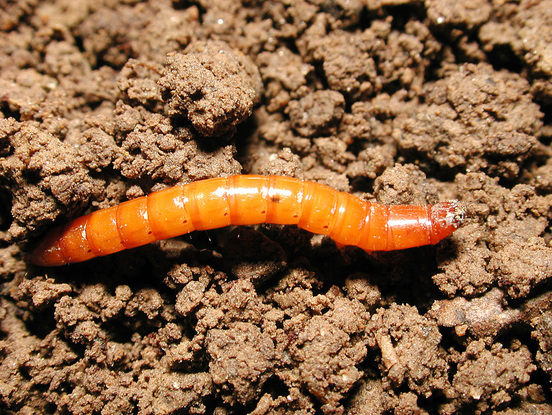 This spring we put two new raised beds in our garden and filled the beds with a mixture of our own Living Worm Compost and a topsoil blend that we purchased from our favorite local supplier. I planted my early crops, weeded and waited. About a week before my pak choi cabbages were ready to harvest I noticed they were not growing as well as they should have been. So being a curious gardener, I investigated, both above and below the ground! In the soil I noticed a small reddish-brown worm-like creature that I had never encountered before. Folks, my lovely topsoil blend that I bought from our favorite local supplier came with its own batch of wireworms! And wireworms, it turns out, are bad news. They eat the roots of plants, attack seedlings, and bore holes into potatoes, radishes, and carrots. I promptly called the local supplier to let them know they sold me tainted soil and asked them for suggestions on ridding my garden of these nasty critters. Unfortunately their only solutions involved chemicals, and lots of them! No thank you! So like any good Master Gardener worth her weight in compost, I did a bit of my own research. I soon discovered that beneficial nematodes would do the trick and clear these things right up. Now, what in the world is a beneficial nematode you ask? Let me explain. Beneficial Nematodes (Steinernema feltiae) are effective killers of any pest that lives in or on the soil, but they’re safe for humans, pets, plants, and earthworms. These amazing microscopic parasites continue working in your soil for 18 months after application. Some of the 230 pests that beneficial nematodes can destroy include wireworms, white grubs, fungus gnats, and black vine weevils…just to name a few. I ended up ordering my nematodes online since the discovery was made on a holiday weekend and I was unable to find them locally. While I waited for my order to arrive I did try an old-time remedy I found online: I cut a potato in half and stuck a stake in it then buried it in the soil. The wireworms were attracted to the potato and ultimately left my plants alone while I waited for my beneficial nematodes to arrive. (In my opinion, the potato trick was a nice temporary fix, but would not have saved my garden; the beneficial nematodes were absolutely necessary to fix the problem. However, seeing that potato draw in the wireworms did help me feel like I was being proactive while I waited for my nematode delivery.) Like all organic remedies the beneficial nematodes took a few days to work, and I will have to apply them again next season just to be sure I don’t see wireworms again. But that’s a small price to pay for a pest-free, and chemical-free, garden. -Corey Veldheer, Certified Master Gardener and owner of Good Sweet Earth
1 Comment
Heather
3/6/2021 03:49:13 pm
Hi there I just discovered some of these worms in my compost and was wondering where to other these nematodes. Thanks!
Reply
Your comment will be posted after it is approved.
Leave a Reply. |
